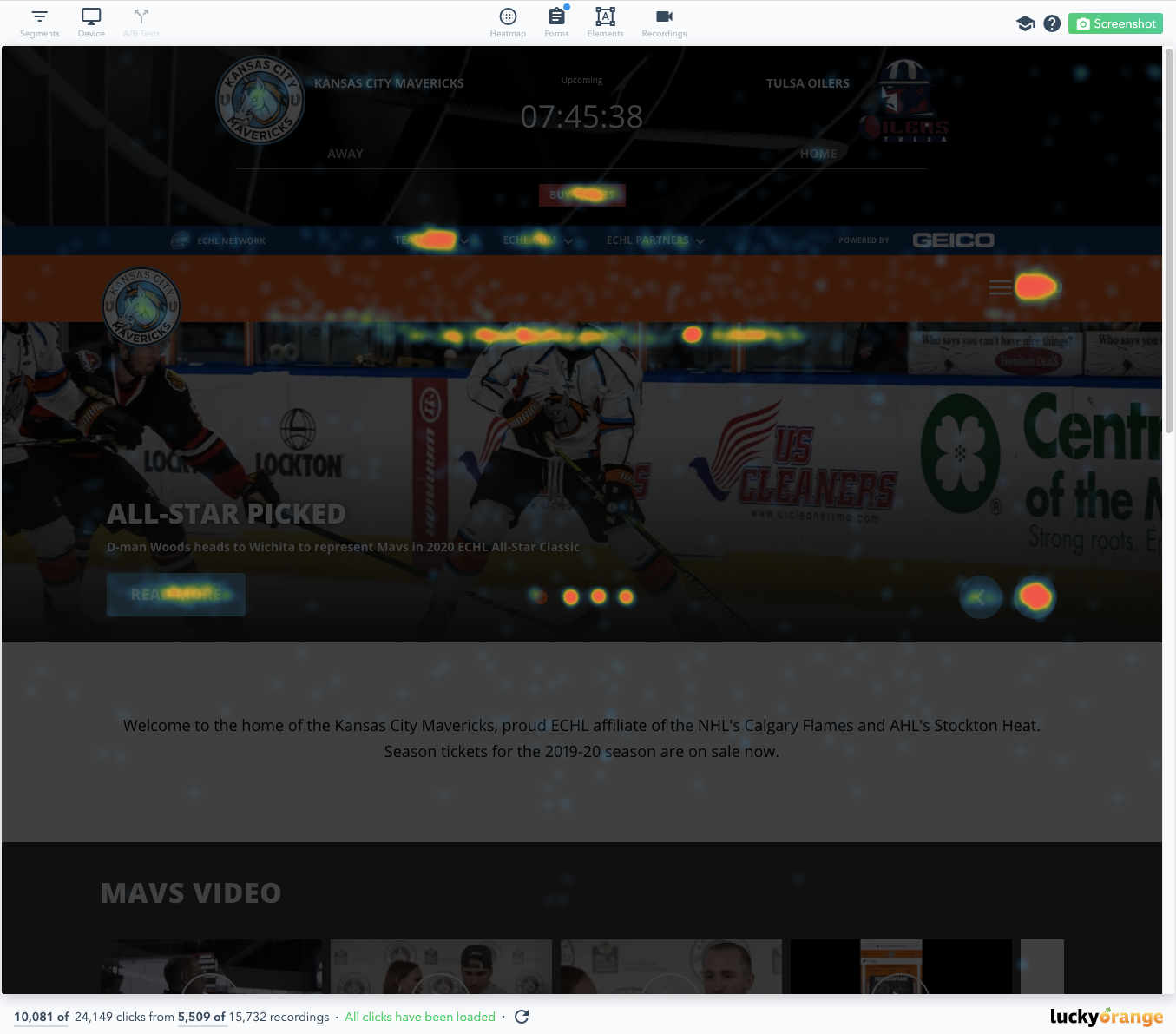We work hard in our roles whether in SEO, paid search, or other aspects of digital and broader marketing trying to get people to our websites.
Websites are focal points for our messaging and getting our audiences to take key actions that we can monetize.
While large brands and marketing firms often have roles and teams that are responsible for the performance of websites, once a visitor enters them through to the final goal or conversion, that’s not the reality for most of us.
Most of us have to rely on our own tools and abilities to monitor user behavior on our sites with the goal of finding ways to improve moving users through the funnel to ultimately get to our conversion goals.
Or, worse yet, we’re leaving that up to chance as we’re already overloaded working on driving organic and paid traffic to our sites to keep the top of the funnel full.
Regardless of where we find ourselves, there are distinct categories of user behavior and we can dig into and specific tools to make our lives easier working to evaluate and improve each of them.
1. User Experience
User experience (UX) is probably the broadest category of user behavior and it could be argued that all user behavior is impacted by it.
It can be difficult to track and measure and often requires collaboration between designers, developers, and marketers if you or your team don’t have a specific role for it.
Behavior to Track
- In-page clicks & mouse movement
- Scroll depth
- User navigation patterns
- Live visitors
- Recordings
- Site speed
How to Get the Data
There are great tools on the market that give us the depth and quality of information that Google Analytics lacks.
We can watch individual visitors live as they navigate through our sites or recordings of their sessions with tools like Lucky Orange, Crazy Egg, and Hotjar.
We also have the ability to review aggregated data and visualizations of how deep visitors scroll, where their mouse pointer goes on the screen, how much time they spend on pages, and much more.
There’s a lot to be gained in these third-party tools beyond what GA can provide and it is important to look at both together to get a complete picture of user experience.
What to Do with the Data
With in-page user experience data you can make decisions that will:
- Help retain visitors on pages.
- Ensure they see the content you want them to.
- Learn how to improve navigation flow to nudge them along to the next page or call to action.
Understanding how users actually use the site versus how you planned or wanted them to is a critical aspect to know and interpret from the data you can collect in user experience tools.

2. Content Performance
Content is fuel for marketing.
It is the foundation and reason why someone comes to our sites.
It’s also what they engage with, whether they spend hours and dozens of visits to our site or if they are coming to a single landing page and converting.
Behavior to Track
- Popularity
- Sharing
- Engagement
- Bounces & Exits
How to Get the Data
Google Analytics is a great direct source of content performance data.
With it we can filter and track which pages are most popular, which search terms (if we have configured GA to see site search data) are being searched, frequency and repeat visits, and what content has the most bounces and exits.
By default, most of these metrics are tracked in GA and we simply have to drill down and filter our way to seeing each layer and meaningful data point.
What to Do with the Data
When we have data showing us what content is getting the most engagement within the site, how people are getting to the content, and what they are doing when they consume it and move to a next step, we can further shape and refine our content strategies.
This includes blog content and impacts the editorial calendar. It also can spell out changes for evergreen content about products or services.
Coupling the content data with the UX data noted previously, we can paint a picture of how we should format our content into sections, pages, sub-pages, and make it as consumable as possible.
3. Conversion Rate Optimization
Conversions are defined by us. They are what we want our site visitors to do.
Whether it is an ecommerce transaction, a lead form submission, or certain subsets of engagement goals, we are typically measuring performance toward a goal.
Optimizing the number of conversions per the number of visits is key to make sure the site is performing at as well as it could and should.
Additionally, the path leading immediately up to a conversion is important.
When we have prospects ready to inquire or buy, we need to get out of their way and make it easy to do. The steps directly leading to conversions have to be measured.
Behavior to Track
- Funnel
- Checkout process
- Variable testing
- Form testing
How to Get the Data
There are several great tools to help with CRO.
These range from Google Analytics to UX tools (e.g., Lucky Orange) to variable testing tools (e.g., Optimizely).
With these tools we can gain insight into how people go through our defined conversion funnels like checkout or form submission processes.
We can also perform variable testing and see how different forms, content, and pages perform.
There’s power in gaining insights into what form field causes users to bail from a conversion process or what page is tripping them up in checking out.
What to Do with the Data
We have the power to improve and test when it comes to CRO data.
This is powerful data as we can ensure that we’re maxing out our return on investment in marketing activities in sending more traffic to the site by ensuring that as much of it as possible is actually converting.
4. Accessibility
Website accessibility has become a growing issue in the past decade.
In the absence of concrete laws and standards, generally accepted ones have emerged based on litigation.
If your organization provides a hostile user experience to those who need added accessibility aids in navigating our sites, you could lose more than just revenue. You may also lose larger sums through lawsuits and litigation.
Behavior to Track
- Testing & Validation
- Live Site Tools
How to Get the Data
I’m not going to go in-depth on this one as there is a wide range of tools and approaches to website accessibility.
There are free tools like the Lighthouse auditing tool in Google Chrome Developer Tools all the way to enterprise paid tools (e.g., BoIA) and services for analyzing websites and how they meet (or don’t) WCAG and other standards.
What to Do with the Data
With the risk of alienating site visitors and potential litigation, it is important to seek legal advice and sound dev and IT solutions to utilize accessibility data and find a plan that works for your website and organization.
5. Engagement
Not every visit leads to a conversion.
A customer journey might require multiple website visits before prospects move from research mode to buying mode.
We must guide and assist our website visitors at each step – by engaging them and helping them along the way.
Behavior to Track
- Live Chat
- Chatbots / AI
How to Get the Data
Through the use of live chat and automated features, we can gain a new level of user data.
Beyond just page and in-page analytics for FAQ and help content, we can actually engage with site visitors.
Many sites already use live chat or chatbots as an extra aid for visitors or as a sales tool.
Review the analytics in these tools or notes in CRM to mine for specific data points on:
- Questions asked.
- Frequent issues.
- Why users are typically engaging with these tools.
What to Do with the Data
With data from chat and AI tools, you can find common questions, hangups, and determine if there’s an issue with UX, with content, the conversion process, and more.
Live human interaction data is an extra layer that analytics data can’t give us.
Work with your team who owns these interactions and this data to see if you can find marketing uses for it and ways to improve your website overall.
If more than one person has the same question, you should probably find a way to answer it – without hoping your visitors will ask.
6. External Data
If you really want to dig deep and go beyond what is happening on the site and understand what users want, you can create a survey.
There are many tools (e.g., SurveyMonkey) that are free or affordable to set up and deploy.
You can also do first-party research with your own customers, prospects, and stakeholders.
The goal of gaining external data is to leverage it in improvements in the site.
You can find out things like what people think about your content, brand, and navigation, or why someone might be more comfortable calling versus conducting a transaction online.
Conclusion
User data is super important.
We all need it no matter how we’re driving traffic to our sites.
There’s nothing worse than finding out that you left revenue or profit on the table because a form wasn’t optimized or visitors weren’t clearly guided to the next step in a buying process.
Through the use of specific tools in the categories of user experience, content performance, conversion rate optimization, accessibility, engagement, conversions, and external data, we can develop or own methodologies for ensuring we have the pulse of how our sites are performing and keeping the user first.
Tracking user behavior will help us get the maximum return on our investment in search and marketing.
More Resources:
- How User Behavior In Search Works: Everything You Need to Know
- How to Use User Behavior Analytics to Increase Your Conversions: 5 Tips
- 11 Ways to Increase User Engagement & Why It Matters for SEO
Image Credits
Screenshot taken by author, January 2020





